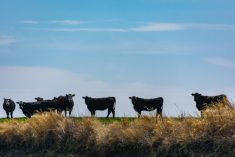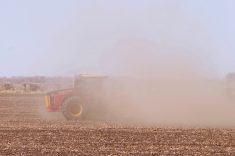I bet that most of us have a lot of “stuff” on our ranches. The stuff I am referring to is anything that is not water, grass or cows. These could be considered the three parts of the ranching picture, and the stuff is what helps us manage those three parts. Stuff includes things such as infrastructure (fences, corrals and water troughs) but other tools that help us to do our management job, such as laptops, 9/16” wrenches and loader tractors.
Stuff is great, as it empowers us to manage cows and grass and water to produce a product, but there are a few challenges we always need to be aware of. The first potential pitfall is that stuff can empower the wrong action. By this I mean that there are a lot of cool tools that let us accomplish ever-increasing and involved tasks with more ease than ever before.
Read Also

Harvest wraps up and fall work begins
At the Eppich famly ranch in western Saskatchewan, the fall harvest was successful with few breakdowns, cows and calves have been sorted and a new tractor has arrived
However, it is important to ask, “Is this a task that I should be doing?” before investing in the tool. This can be something as expensive as a new loader tractor or a baler, or as simple as a set of tagging pliers. The first question probably shouldn’t be “Do I need/want the tractor or the tagging pliers?” A better first question might be “Why do I need a loader tractor, or is there an alternative?”, or “Should I be making my own hay?”, or “Does tagging calves at birth add value?” In all these examples the answer may be that you need the tool, but I believe it is important to why first.
Remember the forgotten costs
The second challenge with stuff is the importance of forgotten costs. We all remember the payments (or at least the bank does), but stuff comes with two types of costs beyond the purchase price. These are depreciation/replacement and maintenance/operating costs.
Depreciation is a complex topic, but it basically amounts to the fact that a tool is worth less after you use it. In other words, if you buy a $200,000 loader tractor, it may only be worth $150,000 in five years. That $50,000 difference is depreciation ($200,000 – $150,000 = $50,000.) If in five years, the same spec loader tractor costs $250,000 then the replacement cost is $100,000 ($250,000 – $150,000 = $100,000.)
Over the five years you own it, the tractor in this example needs to provide you at least $100,000 worth of work ($20,000 per year) to justify its purchase and future replacement. Additionally, if that tractor is operating to produce that work, it also must be operated by someone (until you can buy an autonomous tractor from Tesla) and it will take maintenance such as fuel, oil, filters, and tires, along with other materials. These costs must also be added into the work that the stuff (in this case the tractor) is doing.
Forgotten costs are insidious as they can sap profit from and add risk to the business. Even the stuff that we intend to keep forever will generally have maintenance and operational costs of which we need to be aware.
Forever stuff costs too
For example, that new heated shop will require ongoing upkeep and utilities, and even the best fence needs some posts and wire once in a while. These factors are true for all the stuff on a ranch. Sometimes newer or better stuff can let us accomplish more or can help us to reduce costs. A new truck may be more fuel efficient than the old one, or a machine with warranty may help to reduce repair costs or improve quality of life for the rancher. The best example of this on our operation is the upgrading of corral systems, replacing wood with steel, but we must always remember that as we add stuff, these corresponding hidden costs will tend to increase.
I have no concerns with people having nice things or even having stuff that is beyond the needs of the operation, as long as they are aware of that fact. There are very few 10-cow operations that require a $50,000-plus tractor, but it is fine to have one as long as you are aware it is a want versus a need. It is also entirely possible to not have the right tools to do jobs that should be done, adding labour and frustration to the business of ranching and under-investing in tools to accomplish important tasks may be just as bad as having too many things.
I think that stuff is very important as it is one of the places where the balance sheet and the cash flow statement collide. Very profitable ranches may have very little or a lot of stuff on their balance sheet (most tend to have very little relative to other assets.)
The key point is that the stuff they have empowers them to be more productive and generates cash flow by positively impacting one of or all of the triage of grass, water or cows. Before you invest in the next thing, take a look at your flesh-to-steel ratio. In other words, we use cows (flesh) to convert water and grass into marketable product. By being aware of the value of your cows relative to the other stuff on your ranch, you will be in a much more powerful position to make good management decisions. Hopefully, this reflection will help lead to asking if the stuff you have is empowering progress or enabling jobs that shouldn’t be done to start with.















